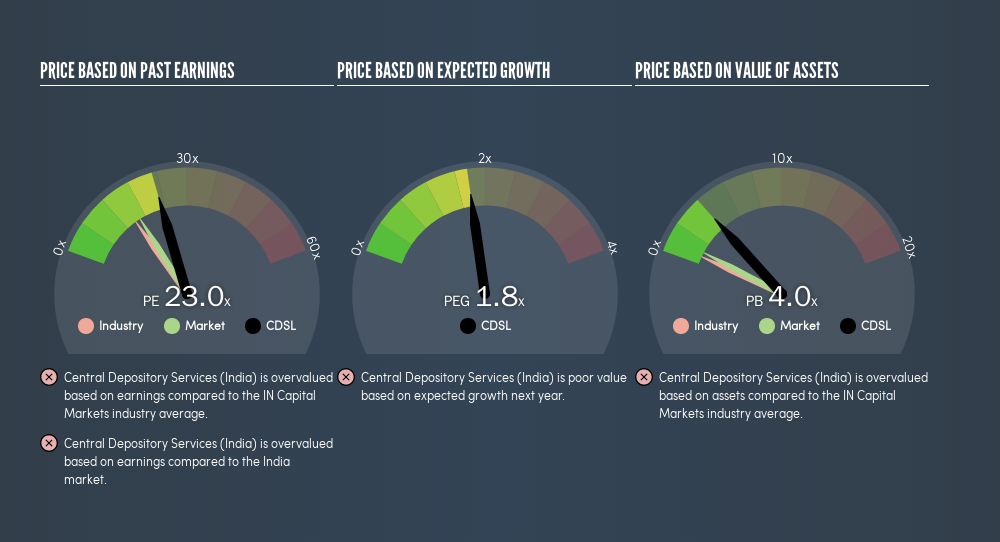- India
- /
- Capital Markets
- /
- NSEI:CDSL
Why Central Depository Services (India) Limited's (NSE:CDSL) High P/E Ratio Isn't Necessarily A Bad Thing

This article is written for those who want to get better at using price to earnings ratios (P/E ratios). We'll show how you can use Central Depository Services (India) Limited's (NSE:CDSL) P/E ratio to inform your assessment of the investment opportunity. Looking at earnings over the last twelve months, Central Depository Services (India) has a P/E ratio of 23.05. That is equivalent to an earnings yield of about 4.3%.
Check out our latest analysis for Central Depository Services (India)
How Do You Calculate Central Depository Services (India)'s P/E Ratio?
The formula for P/E is:
Price to Earnings Ratio = Price per Share ÷ Earnings per Share (EPS)
Or for Central Depository Services (India):
P/E of 23.05 = ₹233.3 ÷ ₹10.12 (Based on the trailing twelve months to December 2018.)
Is A High Price-to-Earnings Ratio Good?
A higher P/E ratio means that buyers have to pay a higher price for each ₹1 the company has earned over the last year. That isn't a good or a bad thing on its own, but a high P/E means that buyers have a higher opinion of the business's prospects, relative to stocks with a lower P/E.
How Growth Rates Impact P/E Ratios
Earnings growth rates have a big influence on P/E ratios. If earnings are growing quickly, then the 'E' in the equation will increase faster than it would otherwise. Therefore, even if you pay a high multiple of earnings now, that multiple will become lower in the future. Then, a lower P/E should attract more buyers, pushing the share price up.
Central Depository Services (India) increased earnings per share by 5.0% last year. And it has bolstered its earnings per share by 17% per year over the last five years.
How Does Central Depository Services (India)'s P/E Ratio Compare To Its Peers?
One good way to get a quick read on what market participants expect of a company is to look at its P/E ratio. As you can see below, Central Depository Services (India) has a higher P/E than the average company (14.9) in the capital markets industry.

Its relatively high P/E ratio indicates that Central Depository Services (India) shareholders think it will perform better than other companies in its industry classification. The market is optimistic about the future, but that doesn't guarantee future growth. So investors should delve deeper. I like to check if company insiders have been buying or selling.
A Limitation: P/E Ratios Ignore Debt and Cash In The Bank
One drawback of using a P/E ratio is that it considers market capitalization, but not the balance sheet. In other words, it does not consider any debt or cash that the company may have on the balance sheet. The exact same company would hypothetically deserve a higher P/E ratio if it had a strong balance sheet, than if it had a weak one with lots of debt, because a cashed up company can spend on growth.
Such expenditure might be good or bad, in the long term, but the point here is that the balance sheet is not reflected by this ratio.
How Does Central Depository Services (India)'s Debt Impact Its P/E Ratio?
Since Central Depository Services (India) holds net cash of ₹2.3b, it can spend on growth, justifying a higher P/E ratio than otherwise.
The Bottom Line On Central Depository Services (India)'s P/E Ratio
Central Depository Services (India) trades on a P/E ratio of 23, which is above the IN market average of 16.3. Recent earnings growth wasn't bad. And the net cash position provides the company with multiple options. The high P/E suggests the market thinks further growth will come.
When the market is wrong about a stock, it gives savvy investors an opportunity. If the reality for a company is better than it expects, you can make money by buying and holding for the long term. So this freevisualization of the analyst consensus on future earnings could help you make the right decision about whether to buy, sell, or hold.
Of course, you might find a fantastic investment by looking at a few good candidates. So take a peek at this freelist of companies with modest (or no) debt, trading on a P/E below 20.
We aim to bring you long-term focused research analysis driven by fundamental data. Note that our analysis may not factor in the latest price-sensitive company announcements or qualitative material.
If you spot an error that warrants correction, please contact the editor at editorial-team@simplywallst.com. This article by Simply Wall St is general in nature. It does not constitute a recommendation to buy or sell any stock, and does not take account of your objectives, or your financial situation. Simply Wall St has no position in the stocks mentioned. Thank you for reading.
About NSEI:CDSL
Central Depository Services (India)
Provides depository services in India.
Excellent balance sheet with proven track record.
Market Insights
Community Narratives



